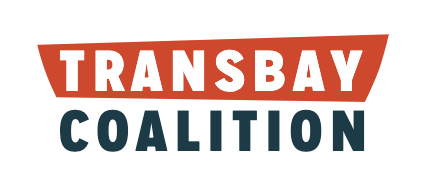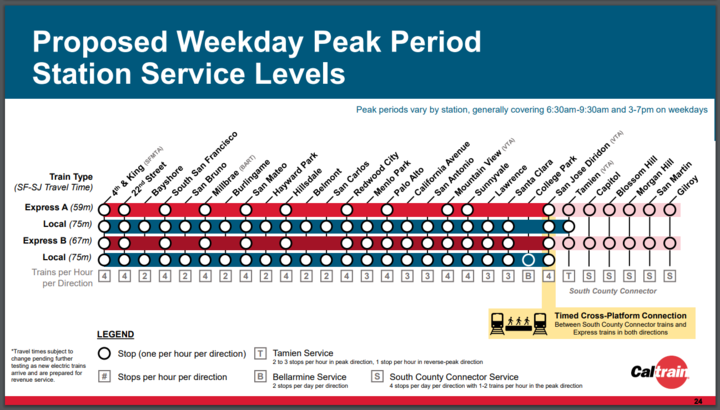The schedule for electrified Caltrain service is being planned now. Electric service is scheduled to go live in September, as construction nears completion and testing is under way. This week, at Caltrain’s Citizens Advisory Committee (September 20, start time 5:40) and Bicycle and Active Transportation Committee (September 21, start time 5:45) will review the proposed schedule. Read on, and if you have comments, you can zoom in to these meetings, or send comments to board@caltrain.com
Some highlights on the welcome improvements – faster, more frequent service with electric trains:
Express trains will make the trip between San Francisco and San Jose in under 60 minutesMore stations will see more stops – the electric trains accelerate more quickly, which allows more stations to be served All stations will see service every 30 minutes, with 11 stations getting 4 trains per hour and 5 stations seeing 3 trains per peak hourAll-electric service with new trains between San Francisco and San JoseGilroy passengers will have to change at Diridon but will see nearly 30 minutes faster service
Caltrain is proposing consistent 30 half-hourly off-peak service in the early morning, miid-day and evenings, between approximately 5-6:30am, 9:30am-3pm, and 7pm-1am.
More service to underserved stations and communities
The electric trains and new service plan provide service to places that had been underserved in the past, with concentrations of homes and jobs, and with current and planned growth.
Stations including South San Francisco, Sunnyvale Downtown and Lawrence (Sunnyvale/Santa Clara) have large populations near the corridor but only see limited service today.
In planning its service, Caltrain is considering equity priority communities serving minority and low -income riders. This is in line with Caltrain’s “Equity and Connectivity” strategy in its adopted business plan from 2019/2020, and has the potential to serve groups of riders who were under-represented in Caltrain’s customer base.
The new schedule enables better connections with local transit – useful overall and for the more than 50% of Caltrain ridership who report not having access to a car for their trips, including people with low incomes, students, seniors and people with disabilities.
Next fall, when Caltrain rolls out electric service, MTC is also planning to roll out the next-generation Clipper system with free and reduced price transfers that will further increase convenience and affordability for all and especially low income riders.
The chart below shows stations that are candidates for increased service based on criteria including population (homes and jobs), equity and transit connections.
BART connection challenges
The schedule will help Caltrain make connections to other transit services.
Unfortunately, BART’s most recent schedule change – designed to increase ridership with increased evening and weekend service, worsens the Caltrain connection, by reducing service to Millbrae from every 15 minutes – which can dovetail nicely with a 30 minute Caltrain schedule, to every 20 minutes – which creates gap-toothed connections. Half of the transfers have 18 minutes between trains, which will discourage some time-sensitive riders.
Missing info on critical weekend service
The slides posted as of Wednesday afternoon don’t say anything about weekend service. Weekend service is important since weekend ridership has regrown more rapidly among regional services. BART’s weekend ridership is over 60% of pre-pandemic levels while weekday ridership is in the 40s. WETA’s ferries are seeing weekend ridership higher than pre-pandemic level.
Especially as traditional white collar commute levels remain lower due to increased work from home, the use of transit for entertainment and non-office commutes is an important opportunity for ridership growth.
Missing vision – less than world-class service
The proposed service plan has less service than was initially contemplated in Caltrain’s Business Plan before the pandemic. The reason is partly financial – Caltrain’s ridership is lower, at about 40% of pre-pandemic level, and lower fare revenue is forecast to lead to budget challenges in FY 25/26. Budget variables include ridership and fare regrowth, and developing a better estimate of the cost of electric power.
Caltrain is proposing to make future service increases “dependent on ridership recovery.” This would leave Caltrain with half of BART service as a baseline. This perspective may still be anchored in Caltrain’s history and mindset as a “commuter rail” service that focuses on serving white collar workers with 9-5 schedules.
Waiting for trains to fill up makes some sense with a baseline of trains every 15 minutes, but makes less sense with a 30 minute baseline or worse. People who are meeting friends for dinner or taking the train to a doctor’s appointment are less likely to take the train if they have to wait 30 minutes for the next train home.
By contrast, the international “regional rail” service model, discussed at the recent “Beyond Commuter Rail” panel discussion provides frequent all-day, all-week service, serving many commuters, among a wider array of riders and trip purposes. Regions with this service model have seen stronger post-Covid ridership recovery, even in regions that have many white collar jobs and significant increase in working from home. For example, Vancouver in North America was back to 80% of pre-Covid ridership in 2022. Recent events organized by Seamless Bay Area learning from transit practices in Switzerland and Sweden highlighted strong ridership recovery in regions with high post-Covid telework.
In this year’s partially successful state budget advocacy, seeking funding to avert the “fiscal cliff” facing Caltrain and other Bay Area agencies, a “nightmare scenario” was BART shrinking to hourly weekend service. BART’s most recent service change targeted at regrowing ridership reduced frequency somewhat at the white collar peak commute period and increased service to every 20 minutes at worst.
Meanwhile, the region is planning a public transportation ballot measure for 2026 with a strong focus on operating funding. And a statewide task force is being convened studying opportunities for California to do a better job of funding transit operations.
Even if Caltrain does not yet have the budget in 2024 to match BART’s service levels, it would make a lot of sense to create a “worldclass schedule goal” of all-day frequent service, well-connected with BART, that could be funded with a regional ballot measure or state sources.
You can watch and listen to Caltrain’s proposal and share your thoughts tonight, Wednesday 9/20, Thursday 9/21, at next week’s Caltrain board committee meetings or October board meeting. And you can also send your toughts to board@caltrain.com. Feel free to copy us at friends@friendsofcaltrain.com
Spiffy new trains – come see them on Saturday
The new trains are nice – quieter, with free wifi and power outlets at every seat. If you haven’t seen them yet – or even if you have, Caltrain is showing off the new trains this coming weekend in San Francisco. Click here to register for a tour to avoid long lines.
.

